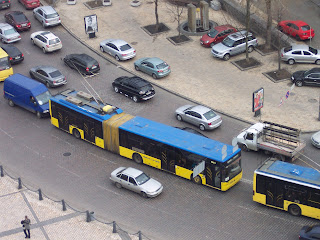I have recently returned from a short visit to Dnipropetrovs’k where I gave a couple lectures. Dnipropetrovs'k was once closed to everyone outside the USSR due to the top secret missile defense systems and industry located here. This is a beautiful and interesting city and wish I could have stayed longer. The faculty at the university were highly welcoming and generous. They are also highly committed to providing effective and appropriate services to students with disabilities.
I presented two lectures at Dnipropetrovs’k National University in Dnipropetrovs’k, one on Early Detection of Hearing Loss and the other on Developing Individual Education Plans. Giving lectures in Ukraine is extremely gratifying, as attendees tend be much more receptive and attentive. Even my young deaf students at the school for the deaf in Luhans’k are far more respectful and attentive than my high school students in the U.S. I am going to be spoiled when I return home.
I also had an opportunity to visit a school for the deaf in Dnipropetrovs'k. The quality of instruction is excellent, and I would say it was just as effective and cutting edge as some of the best private schools for the deaf in the U.S. I'd be interested in knowing the reading levels and academic achievement of the school's graduates. I'm also curious about the selection process. How are children admitted the school, and what are the admission criteria? I am under the impression it is a public school, so do all children have equal opportunity to attend?
At the conclusion of our visit to the school, I was presented with a gift from the faculty and students. It is a picture made of glass beads by one of the deaf students. The photo below does not show just how beautiful it is. I wish the art had been signed, so it remains anonymous.
There were two of us lecturing in Dnipropetrovs’k. The other individual was Dr. Daniel Leitch. He is a special education professor at the University of Wisconsin in Platteville and is a Fulbright Scholar teaching at Ukrainian Catholic University in Lviv. His very excellent lectures were Inclusive Practicies in Wisconsin, USA and Transitioning youth from prison to Community.
As I mentioned, the people at were Dnipropetrovs’k National University were extremely welcoming and generous. After each lecture, our hosts invited us to delightful afternoon teas with delicious food and enlightening conversation. Of course, there was also the traditonal custom of sharing multiple toasts over cognac.
 |
| A view of the Dnieper River in Dnipropetrovs'k, one of the largest rivers in Europe. |
 |
| Dnieper River |
 |
| Two electric trams passing each other in Dnipropetrovs’k |
 |
Another electric tram. These are used
quite extensively in Dnipropetrovs’k. They
would be beneficial in the U.S., as well. |
 |
| Memorial to the Unknown Soldier |
 |
| Memorial to fallen soldiers |
 |
| Artillery used in the battle for Dnipropetrovs'k during World War II |
 |
| World War II Soviet Rockets |
 |
The first tank to enter Dnipropetrovs'k during the liberation of the
city from the Germans. The driver was killed by a German sniper. |
 |
| History Museum |
 |
| Library |
 |
| National Mining University |
 |
| A 19th century home built by the founder of Dnepropetrovsk State Agricultural University |
 |
| Auditorium of the National University |
 |
| Ancient Stone Figures |
 |
| Memorial to the Cossacks |
 |
Колобок (Kolobok). Kolobok is sitting on the left.
He is a character in a Russian fairy tale - a round
ball of bread dough who comes to life and escapes
from an elderly couple by rolling out of their house.
He also escapes from a series of animals who
would like to eat him, all except a crafty fox.
The plot is very similar to the stories about
the pancake man and the gingerbread man. |
Here is an interesting custom. When a couple gets
married, the bride and groom affix a lock to the
railing of a bridge and throw the key into the river.
Incidentally, the day I took this photo happened
to be International Hug Day, and the woman in the
photo (and a number of other folks) was running
around giving people hugs. She thought I needed one too.
 |
| "Anya and Denis" |
"Sasha and Sveta"
 |
I was surprised to see this bar in Dnipropetrovs'k.
Not the most positive aspect of the American
experience for Ukrainians to celebrate. |



























































